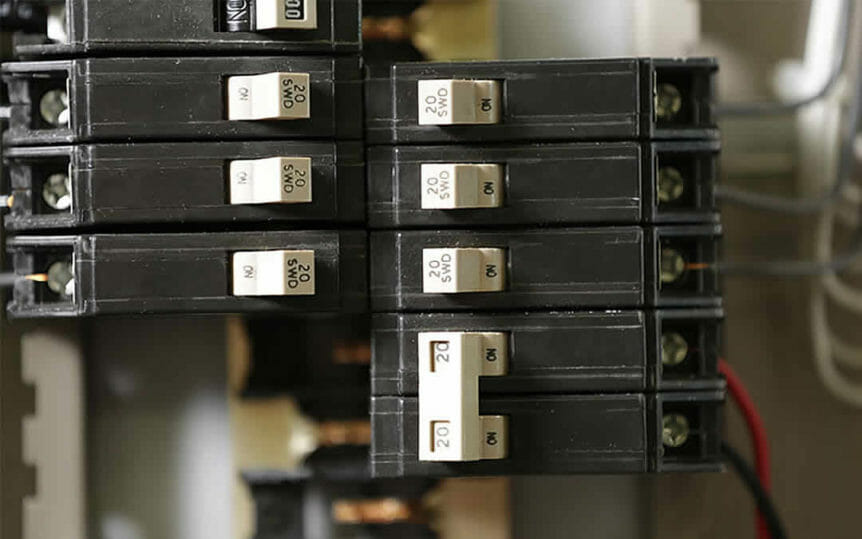
Understand Electricity – Top Reasons For Circuit Breaker Failure
It’s probably happened to you before. All of a sudden, the power is out and you don’t know how it happened. Maybe you were using too many appliances at once, there was an electrical storm, or you had some faulty wiring. Whatever it was, we are sure it’s happened at least once or twice to you, and it’s pretty frustrating, isn’t it?
Most of you find the electrical panel, and reset the circuit breaker. Then,”pop”, it trips again, or it trips again when you are back upstairs and turn back on whatever you were using when it tripped in the first place. What are you supposed to do now? At this point, you need to stop and identify the root cause of the problem.
First, it’s best to understand what breakers are for. Their job is to limit the amount of current flowing on a circuit so that it doesn’t exceed the rated level, which is measured in amps. Breakers are supposed to trip if too much current flows through a circuit or if there is a short circuit. The breaker itself is pretty durable, so it’s rarely the reason for a tripped circuit, but don’t rule it out if the common causes don’t seem to fit the bill.
Here are the most common reasons that your breaker won’t reset. Even if you’ve tried to reset it, don’t lose hope. There is a chance you haven’t done all you can before calling in the pros becomes necessary.
Be Sure To Reset Correctly
Are you taking the proper steps to try to reset the breaker? If you see that one of the breakers is tripped or is in the off position, try to reset it by flipping it tightly from the “off” back to the “on” position. Don’t just flip it to the “on” position. There are actually 3 breaker positions, “off” to the left, “on” to the right and tripped, which is actually in the middle. Many times people just push the switch to the “on” position and it won’t stay on. Remember, you need to push it OFF first to get it to work!
Overloaded Circuit
Remember that time when one of you was heating up some popcorn in the microwave, the other was blending up a smoothie, and then a third person switched on the toaster? We can guess what happened next. The power went out, and all you could hear was someone say “oops” amidst the darkness. You just overloaded the circuit.
Most household circuits operate at 120 volts and 15 amps, and are capable of safely drawing 1,440 watts of power. If the total wattage on the circuit exceeds this, the breaker will trip. Add up the total amount of wattage from appliances and fixtures on the circuit to make sure it doesn’t surpass the circuit’s rating.
If the circuit breaker trips, resets only after it has cooled down, and then trips again after a while, it is likely that the problem is an overloaded circuit. If there are too many lights or appliances on at a time on one circuit, it can overload and cause the breaker to trip. Another cause for an overloaded circuit could be that there is a faulty appliance plugged into it. Remember, your breakers should trip if there is an overload! As we said before, circuit breakers are designed to protect you and are an important safety element for your entire electrical system.
Short Circuit
If the circuit breaker won’t reset, and trips instantly, then you probably have a short in the circuit. This is a more complicated and serious reason for a breaker tripping because it can result in an excessive electric current that can potentially cause circuit damage, overheating, fire or even explosion.
A short is caused when the hot wire (black wire) touches another hot wire or touches a neutral wire (white wire). It can also occur if there is a break in a wire in the circuit. Shorts are a little more difficult to identify because they can be caused by the wiring in your home or in something you have plugged into an outlet. To check for a faulty appliance, unplug the fixtures or appliances one by one and check to see if the breaker stays closed when you reset it. This will identify an appliance that is causing a specific problem.
If the problem persists and you can’t seem to find out what the problem is, or, you do know it’s a short circuit condition, bring in a pro. It’s a good idea to contact an experienced John Moore Services electrician to get it taken care of safely and properly as soon as possible so you avoid dangerous situations.
Ground Fault
Your breaker might be experiencing a ground fault if it isn’t resetting. This is when the hot wire, almost always black, touches the ground wire, which is bare copper, or the side of a metal outlet box. This is another type of short circuit, but it’s best to know it has its own details that need attention, so be careful to not overlook it!
Know When to Say “When”
John Moore electricians are the best of the best when it comes to getting the job done right and doing it safely. That’s why we want you to know everything you can about what is going on with your circuit breakers and other important systems in your home, and why we write all these posts in the first place, y’all! We want you to be prepared. Educating the community is the first step in our work as licensed Houston area electricians. Having said that, you should remember that the smartest option is always the safest, and that means knowing when to let us take over when times get tough. Give us a call right away if you run into any of the problems above. Electricity and wiring are not something to mess around with; don’t be shocked (there’s that pun!) to find out you might not be the electrical genius you thought you were. Always do plenty of research beforehand and talk to someone experienced to get your breaker on the way to recovery.
